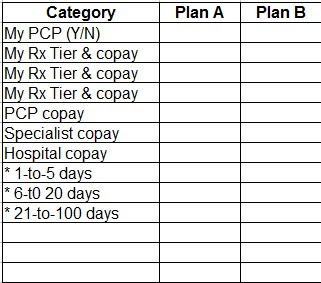THE FOLLOWING are some considerations when selecting a Medicare Advantage plan.
Finding a plan in your area Medicare plans are location dependent. A plan that’s offered in Washington may not be offered in Florida. The best place to find out what plans are available in your area is to go to MEDICARE.GOV. Unlike commercial sites, Medicare.gov lists ALL the plans available in your area. Some commercial plans fail to tell you about plans that may be best for you.
Selecting a Primary Care Physician (PCP) If you have a PCP you want to keep, go to the web sites of the plan providers in which you are interested. Locate the plan's PROVIDERS LIST. This lists primary care physicians, specialists, hospitals, pharmacies, and other health care providers. Bookmark this page; you will come back to it when checking other providers.
Are the plan’s PCPs “capitated?” Some Advantage plans claim patients can see any specialist in their network. If the primary care physician is “capitated,” that physician has an abbreviated list of specialists to which you may be referred; the desired specialist may not be on the physician’s “capitated” list. Finding out may require a phone call or email to the plan and a call to the PCP.
Does the plan cover your prescriptions and what “tier” are the drugs? If you have long-term medications, go to the provider’s web site and find it’s FORMULARY page. Find the drug(s) you take and look at the drug’s TIER level. Most plans have four tier levels and most plans have $0 copays for Tier 1; some have $0 copays for Tier 1 and Tier 2.
To determine the copay for each tier, get the plans EVIDENCE OF COVERAGE from the plan’s web site. This is the MOST IMPORTANT document on the plan’s web site..
The Evidence of Coverage, EOC, is a Medicare-approved document that commits the plan to provide certain services at specific copays for the calendar year. The EOC may be downloaded from the web site; a hard copy will be provided if you sign up for the plan.
- Providers may change, and modifications may be made to the formulary, but benefits are fixed for the duration.
About the EOC Most EOCs closely follow the same format. Benefits are alphabetized – usually in Chapter 4 of the EOC -- and presented as a two-column table or “chart.” The first item on the chart should be Abdominal Aortic Aneurysm Screening with Services not covered as the final entry. (I found one EOC that failed to follow the standard; I quickly ruled that plan out as a possibility.) Many benefits, e.g., breast cancer screenings, PAP smears, colorectal cancer screening, and prostate screenings are $0 copay due to Medicare requirements.
Copays Copays – the patient’s out-of-pocket costs – vary widely. Most, albeit not all plans, have a $0 copay for routine visits to the patient’s PCP. Many have copays for visits to specialists. If you are like many seniors, PCP visits are frequent and specialist visits come with greater regularity than before.
Emergency room visits – always expensive for both the insured and the insurer – are discouraged for “minor” problems, e.g., URIs, cuts and abrasions, even cuts requiring sutures; instead plans wisely direct patients to urgent care facilities. Some plans cover an urgent care visit 100%, others require a copay that always is less than the copay for an ER visit. Most plans offer emergency care worldwide, so subscribers are covered no matter where they need medical care. All plans include the caveat: If you think the ER is necessary, GO!
Hospital stays When I was talking to sales people for my first Advantage plan I was concerned about hospital costs. Some had $0 for the first “n” days then high copays for additional days. The salesman told me – and after three major surgeries I confirmed he was correct – that most hospital stays are five days or less.
Everything else in the EOC deserves your attention since items that apply to you may not apply to others. The EOC’s “chart” is easy to understand and the plan’s Customer Service Reps (CSRs) are available via toll-free numbers for clarification.
I created a spreadsheet listing MY critical issues and then expanding the list by copying each EOC “chart” items. Since I was comparing a number of products, it took several hours, but in the end, I think it was worth the effort.
AGAIN, THE STARTING point is Medicare.Gov
PLAGIARISM is the act of appropriating the literary composition of another, or parts or passages of his writings, or the ideas or language of the same, and passing them off as the product of one’s own mind.

No comments:
Post a Comment